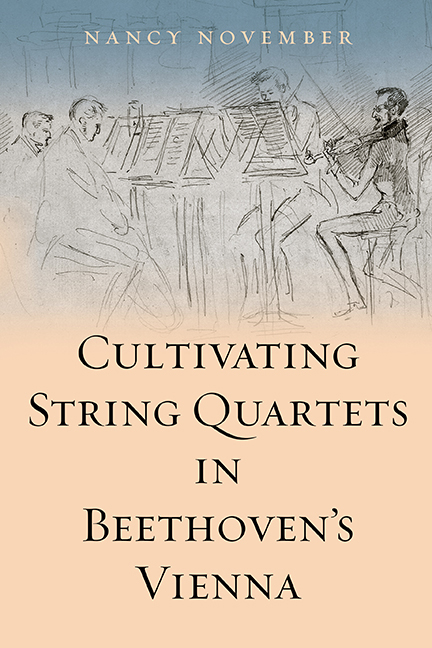Book contents
- Frontmatter
- Contents
- List of Illustrations
- List of Musical Examples
- Acknowledgements
- Introduction
- 1 Defining Chamber Music in the Early Nineteenth Century
- 2 Celebrating Haydn, Cultivating Opera
- 3 Selling String Quartets in Beethoven's Vienna
- 4 Locating String Quartets in Beethoven's Vienna
- 5 Early Nineteenth-Century Performance and Criticism
- 6 Sociability, Showmanship, and Study: ‘Quartet Friends’
- 7 The String Quartet and the Listener
- 8 Schubert's Song, Beethoven's Theatricality
- Epilogue: Constructing ‘Viennese Chamber Music’
- Bibliography
- Index
- Frontmatter
- Contents
- List of Illustrations
- List of Musical Examples
- Acknowledgements
- Introduction
- 1 Defining Chamber Music in the Early Nineteenth Century
- 2 Celebrating Haydn, Cultivating Opera
- 3 Selling String Quartets in Beethoven's Vienna
- 4 Locating String Quartets in Beethoven's Vienna
- 5 Early Nineteenth-Century Performance and Criticism
- 6 Sociability, Showmanship, and Study: ‘Quartet Friends’
- 7 The String Quartet and the Listener
- 8 Schubert's Song, Beethoven's Theatricality
- Epilogue: Constructing ‘Viennese Chamber Music’
- Bibliography
- Index
Summary
As yet we have no history of our classical chamber music, which next to the great masters also treats the connecting and mediating artists of second rank with loyalty and love, and would thus give a complete and genetic overview of the germination and flourishing of our most original and purest form of music – the sonata, the symphony, and the quartet.
Wilhelm Heinrich Riehl, writing in 1878, had to wait. It would be seven more years before the first German history of classical chamber music was published: Ludwig Nohl's Die geschichtliche Entwickelung der Kammermusik und ihre Bedeutung für den Musiker (‘The Historical Development of Chamber Music and its Meaning for the Musician’). Even then, Nohl's history served to cement the trend that Riehl had observed, of elevating canonical composers to the exclusion of others. Nohl's book, which focuses mainly on Beethoven's string quartets, helped to set the tone for the scholarly treatment of classical chamber music's history to the present day.
This book may represent a partial fulfilment of Riehl's wish, although it is more broadly and more critically conceived than he would probably have imagined it. And it does not see the ‘other’ composers as necessarily having merely ‘connecting and mediating’ roles. This study of the Viennese culture of string quartets in Beethoven's era offers new insights into neglected composers and repertoire, understudied private music-making, and a social milieu that is far more complex than scholars of music have usually recognised. The period in question, during and immediately after the Napoleonic wars, was a crucial time of social and musical change: previously ‘private’ music started to be performed publicly and published, but private and semi-private music-making remained vital. The book offers critical perspectives on three paradigms still found in modern-day scholarship, which have since the nineteenth century skewed the understanding of this repertoire: (i) a near-exclusive focus on the canonical composers, Haydn, Mozart, and Beethoven; (ii) a tendency to neglect other contemporary composers’ chamber music, except for limited attention to their string quartets, or to measure them against narrow or anachronistic aesthetic ideals; and (iii) a perception of works of instrumental chamber music as ‘autonomous’, cut off from social situations and meanings.
- Type
- Chapter
- Information
- Publisher: Boydell & BrewerPrint publication year: 2017

